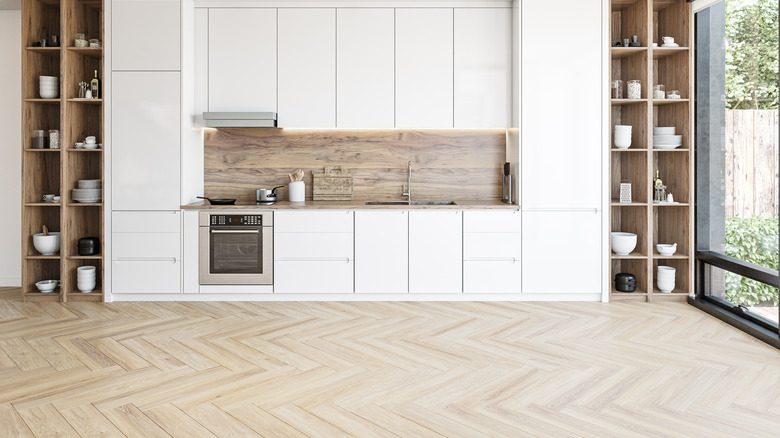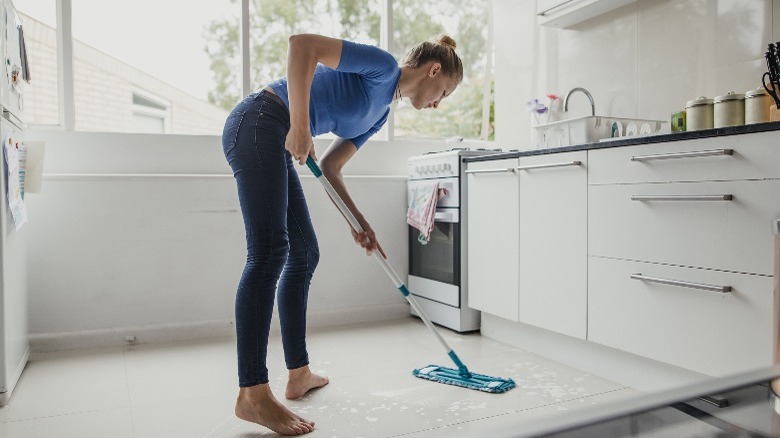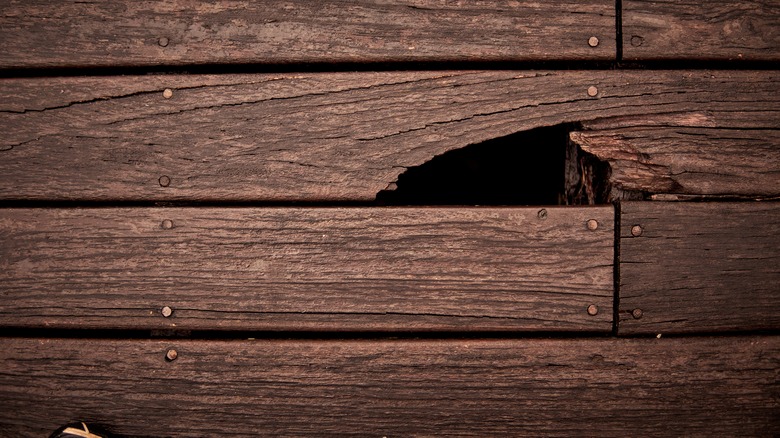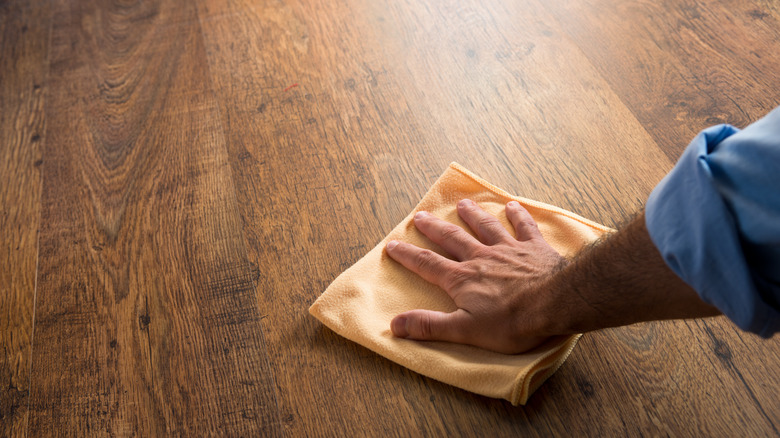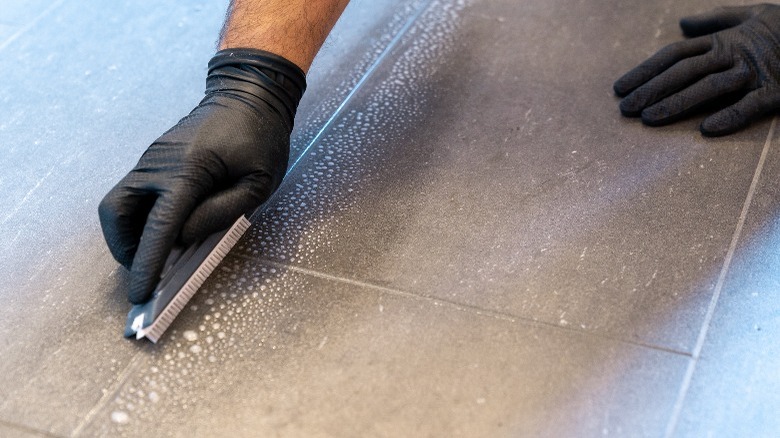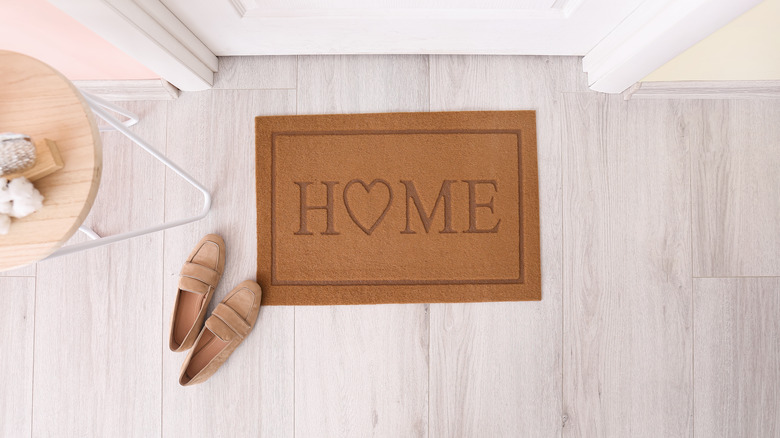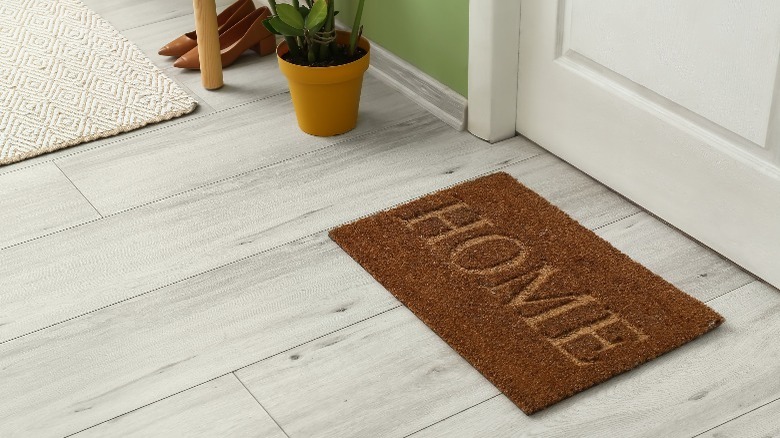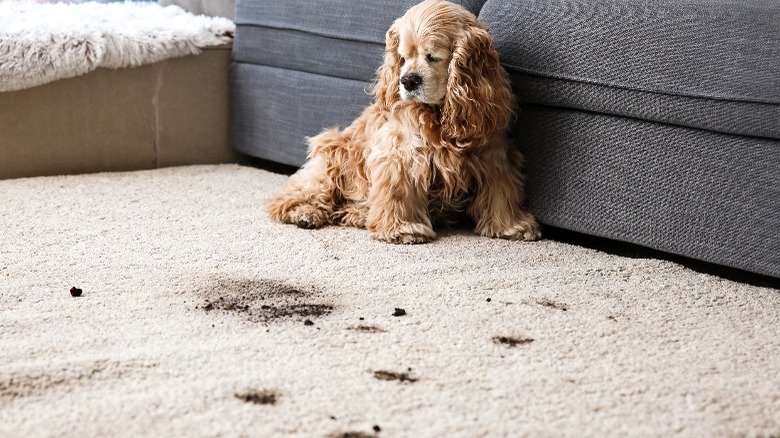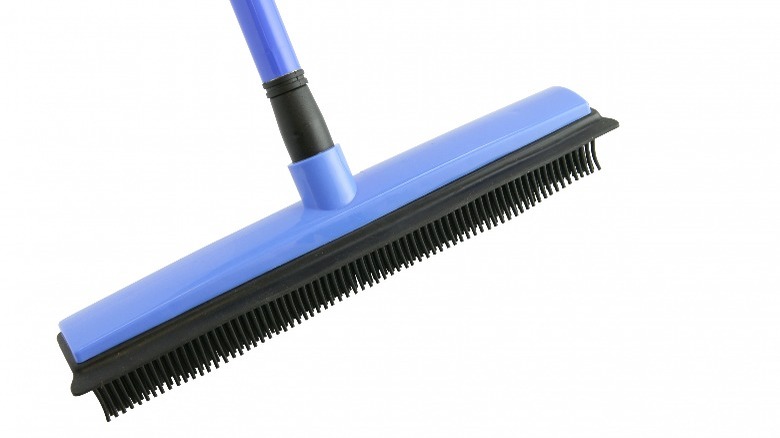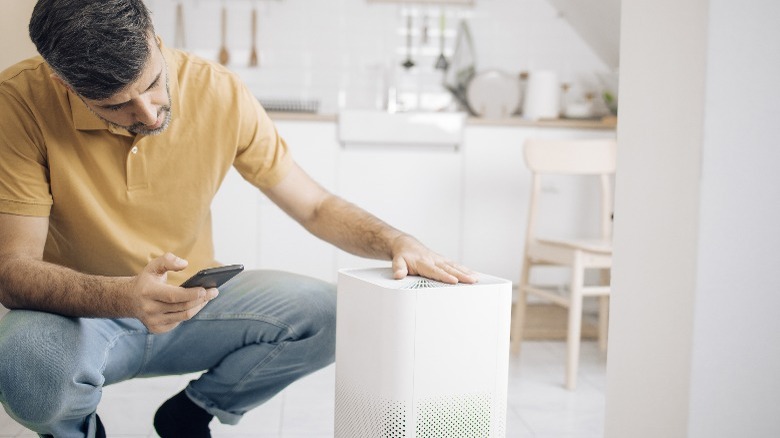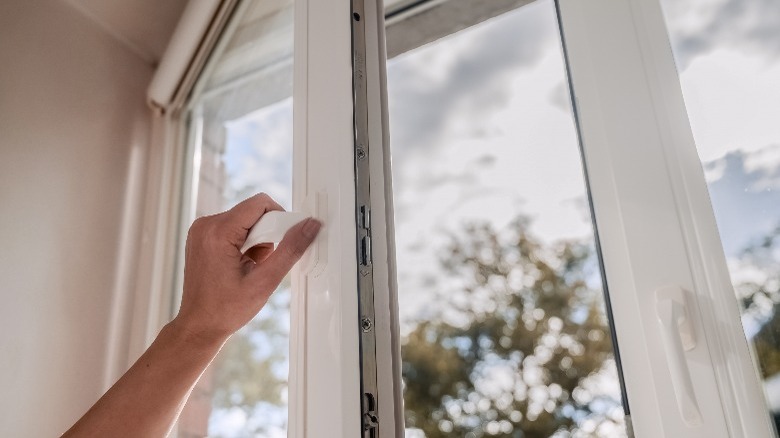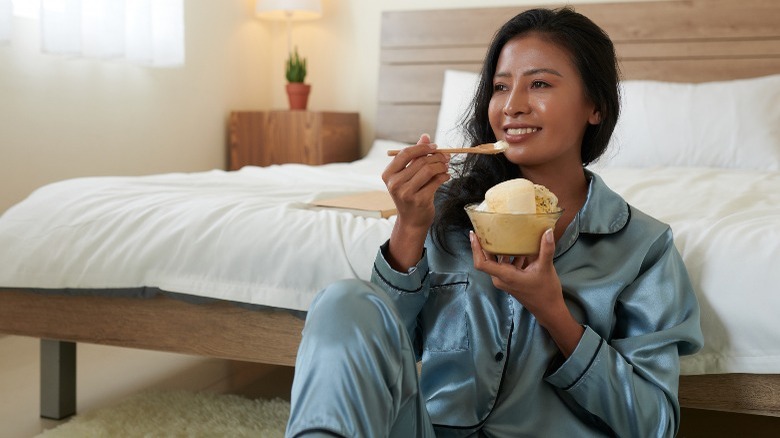Here's How To Keep Your Floors Clean For Longer
Sweeping, mopping, and vacuuming floors can be a dreaded chore, especially when the whole house needs to be done. It can take hours on end and might need to be done once every week or so. But it doesn't have to be that bad — adopting some smart habits will keep your things cleaner for longer.
Floors and carpets become dirty quickly for familiar reasons. The dust and grime can come from outdoors or inside, through windows, food crumbs, or from the bottoms of feet and paws. In addition to that, more traffic creates an extra mess, so certain areas need added protection. And sometimes, using the wrong products and cleaning methods only adds to the problem.
Keeping floors looking their best between cleaning days can be tough, and having children and pets makes it even harder. The tips below focus on preventative measures, teaching you how to set up your house so dust and grime stay off the floor. Having this kind of vigilance will keep your floors looking spotless for longer and will save valuable time when deeper cleanings are needed.
Clean floors the right way
When floors are mopped incorrectly, stains won't come out and product residues can be left behind. That makes them look and feel dirty soon after all the work is done. For a longer-lasting clean, only use products designed for the specific type of floor. This means using pH-neutral, mild soap, and water on hardwood and stone, and vinegar-based solutions on laminate. Baking soda and vinegar can get stains out of tile, and rubbing alcohol or baking soda can clean and brighten linoleum. There won't be any film leftover that needs to be eliminated.
When mopping floors, add 1 tablespoon of soap in the water because any more than that will be left on the floors, making them look dull; the stickiness will also attract dirt sooner. It's important to keep replenishing the bucket with fresh, clean water while mopping; otherwise, the dirt gets pushed right back into the surface. And dry the floor when finished because too much moisture can leave unsightly spots.
Promptly attend to repairs
Cracks and gaps in floors attract small particles and dust that accumulate over time. Things like leftover food, hair, and spilled drinks can fall in and be difficult to remove from those narrow crevices and tiny holes. So even after a floor's been cleaned, the trapped dust and dirt can come out as you walk across the floor, making it look dirtier faster. These imperfections can develop after years, but newer floors can also have this kind of damage. And much of the time, they will expand if not fixed.
When floor cracks and gaps are properly sealed, the new barrier prevents things from getting stuck inside. Clean out the debris first with a narrow pipe cleaner brush, compressed air can, or similar tool. For hardwood boards, use a putty knife to fill the opening with wood filler before sanding and staining it to match the floor. Laminate floors can be repaired with putty or wax crayons, but damaged ceramic tiles cannot be repaired like this and must be replaced.
Prevent wax buildup
If you own hardwood floors, you have probably heard that you should use Murphy Oil Soap, Pledge, or some sort of wax or oil cleaner to keep your floors shiny and polished. But as it turns out, that can actually make your floors dirtier rather than cleaner. The leftover residue can create footprints, smears, and smudges, and it can leave behind a sticky coating that traps floating dust and hair. This will make your floor look dirtier faster. To make things worse, waxing products can make floors look yellow when used too often. The oils and waxes create a thick coating that grows with each application unless the floor is stripped and cleaned. The only way to do that is with denatured alcohol, mineral spirits, or a floor stripper machine.
To avoid this, choose floor products like Pledge No Wax to wash them. You can also make your own. For example, mix 1 cup of vinegar with 1 gallon of water and a few drops of Castille soap for wooden floors.
Give grout some TLC
A freshly cleaned tile floor won't look that way for too long when the grout is stained and dirty. Grout is usually made from sand, which is porous. If its seal has worn off, that allows food, liquids, and debris to penetrate and cause stains. The dirt stays lodged in the joint and comes out when agitated by footsteps or paws. That's why your kitchen floor feels dirty after a few days, even though you just cleaned it.
To keep dirt and grime from building up in grout joints, you need to keep up with resealing. Doing this every three to five years is recommended. When it comes to cleaning, stay away from sponge mops that push unwanted things into them. Microfiber mops don't do this and clean tiles effectively. And when a stain is noticed, try removing it with a Magic Eraser. Give the grout some serious TLC once a year with a deep cleaning, too. This is best done with an angled, stiff nylon bristled brush and a DIY cleaner made with baking soda, hydrogen peroxide, and a bit of dish soap.
Don't wear shoes in the house
Enforcing a shoes-off-in-the-house rule keeps floors cleaner for longer because there will be much less dirt and debris tracked in from outside. Shoes and boots bring in mud, water, grass, and who knows what else onto flooring and carpets. The mess can come from the bottom soles, but debris can also adhere to the sides. And that's not the only problem, because shoes can also leave scratches and dark scuff marks.
This can be a hard habit to get used to, but it is well worth perfecting. Designate shoe areas at the front and back entrances and make sure that everyone removes their footwear before walking inside. There can be a large plastic container, a shoe rack, an old rug, or anything else that will keep the shoes in one place. It's not a bad idea to keep some house shoes and socks in the same spot so no one will have to walk around barefoot.
Have floor mats at the entrances
Floor mats are another way to prevent dirt and grime from getting onto floors, stretching out the time in between floor cleanings. They act as barriers where anyone can stop, think, and wipe off their shoes. The mess stops there.
Place a mat at every entrance, including the ones from the backyard and garage. The main entrance can have an outside rug and a second one right where people step inside. Make sure that they all have a non-skid feature because trips and falls can happen when the backings are slippery. Don't forget to clean and dry the mats often, because they get dirty fast. Leaving them filled with dust and debris will only encourage the grime to spread, especially if the mat is indoors. When choosing indoor floor mats, make sure that the pile height is low enough for the door to completely close.
Mind your pets
Pets bring lots of love into homes, but they also contribute muddy paw prints, fur, spilled food, and unmentionables to floors. A few preventative measures will cut back on all that, and knowing how to quickly clean that stuff up will also keep floors in better shape. Since pets bring in outdoor dirt, debris, and moisture, set up a cleaning station with old towels and wet wipes to use after walks and trips. And because fur takes a while to dry, keep pets confined to a certain area for a while after they come in.
Keep their food area clean and neat too, picking up spills right away. And when they have accidents, use an enzyme-based cleaner to remove the mess and prevent lingering stains and smells from forming. Dogs and cats also shed, and that can lead to more frequent vacuuming. To keep that under control, brush them often; it's best to brush dogs once a day. Do this outside whenever possible, and give dogs regular baths.
Use an electrostatic broom and a microfiber mop
Floor sweeping with a dustpan might seem effective, but rogue crumbs and dust can be missed, and then the surface needs to be cleaned sooner than later. Modern tools can work better and be easier to use. One choice is an electrostatic broom, which has rubber bristles or a polyurethane foam brush at the end. That part is like a magnet and creates static when swept across a floor. It attracts dirt and dust to its bristles, and when you're done using it, you can simply wash it with soap and water.
Microfiber mops are especially good at picking up dust and are less likely to leave behind lint residue that needs to be swept or vacuumed. These are highly recommended for hardwood floors, which are notorious for accumulating dust. These mops pick up more than cotton ones, meaning the floors won't need to be wiped as often.
Use air purifiers
Air purifiers suck up dust and pet hair so they won't land on the ground. The contaminants get pulled in by fans and filtered by the HEPA filters, resulting in clean air recirculated back into the room. Some even have special filters designed to capture pet hair, and most will remove larger dust particles.
When shopping for air purifiers, look for ones with HEPA filters that are at least 99.97% efficient. Avoid ones with electrostatic filters and ionizers, because both can produce potentially harmful ozone. There are portable ones with timers and whole-home air purifiers attached to HVAC systems. The latter kind works through the home's vents and fans. Keep portable ones at least 6 inches away from walls and furniture, and fully away from heat sources. Change the filters according to the manufacturer's instructions for the best results. If you follow all of those steps, once it's running, there will be less hair and dust on the floors.
Keep doors and windows closed
There are a lot of good things about fresh breezes, but dust and dirt particles come in with them, dirtying nice clean floors. It's at its worst on windy days when even more airborne pollutants can sneak in through accommodating doorways and window screens. These openings also allow insects to get in and find their way down to the floors.
Keeping doors and windows closed all time isn't always feasible and pretty undesirable when the weather outside is beautiful. Unless it's especially windy out, feel free to open things up in the early morning. There is less dust because of the morning mist and dew at this time of day. Fine mesh screens can trap some of the dust, and you can keep it off the floor if you wash them regularly. You can also keep your floors clean for longer if you wash your windowsills of any lingering grime, ensuring it doesn't end up inside.
Don't take food out of the kitchen
The last habit here that will keep things from getting onto the floor can be hard to establish since people eat in practically every room of a house. This means that food and drinks can get dropped and spilled on the floor, and then ... ugh, out comes the vacuum and mop once again. Kitchen floors are expected to have crumbs and such, but transporting a bowl of cereal or a full plate to another spot means that the accompanying mess will travel to another room. It needs to be cleaned up right away, because it can leave stains, get moldy, and bacteria can form. And perhaps worst of all, the leftover mess can attract ants, mice, and other hungry creatures.
Set this rule for everyone in the house, including pets. By keeping the crumbs contained to one spot, you ensure it doesn't get tracked all over the house, keeping your floors cleaner for longer.
